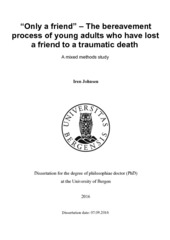| dc.description.abstract | The present study was part of a larger longitudinal project, “Bereaved parents, siblings and friends after Utøya July 22nd 2011”, which was conducted at Center for Crisis Psychology between 2013 and 2016. This sub-study focused on the close friends of those who died in the Utøya-killings of July 22nd 2011, with the main aim of increasing knowledge about what young adults face after they losing a close friend to a traumatizing death. In addition to exploring the level of grief and trauma reactions, the study examined possible relationships between reactions, the level of strain, the consequences for functioning at school or work, and the received and wanted help and support (both from professional helpers and their social network). The study is a prospective and non-experimental mixed methods study, and consist of both quantitative data (questionnaires) and qualitative data (in-depth interviews). Data were collected at three time-points – T1 (19 months post-loss), T2 (28 months post- loss), and T3 (40 months post-loss). Quantitative data were collected at each of the time points (T1, T2 and T3), while qualitative data were collected at T2. The aim of Paper I was to explore the bereaved friends’ situation 1 ½ years after the loss (at T1), with a focus on grief and trauma reactions, psychological distress and psychosocial functioning. The main findings were that bereaved friends reported elevated levels on all symptom measures, with the majority scoring above the cut-off levels for complicated grief, trauma reactions, psychological distress and functional impairment. Many of the friends felt the need for help from the public health services, but only half of these received any help. More experienced need for help was also associated with increased levels of trauma reactions, complicated grief symptoms, psychological distress, functional impairment, and absence from school or work. Gender differences were found for all symptom measures, with females reporting higher levels of both grief and trauma reactions. The qualitative data were the focus of Paper II, and the aim was to explore young adults’ experiences following the loss of a close friend in terms of how they processed the loss, how the grief was influenced by the circumstances concerning the death, what characterized their grief and their main struggles. The main themes identified from the analyses of the interviews were concerned with: 1) how circumstances of the event interfered with the grieving process; 2) the acceptance of the loss; 3) the daily experiences of the loss and adjustment to it; and 4) the recognition of friends as bereaved. The main findings were that the loss of a close friend had a profound effect on the young people, who also felt that the processing of the loss was disturbed by the circumstances concerning the death. In addition, bereaved friends did not feel completely recognized as bereaved, by either the helpers or society. The focus of Paper III was the long-term effects of the loss and the duration of complicated grief over time, as well as how complicated grief was affected by avoidant behavior and rumination. Changes in symptoms over time were measured by a latent growth model, which showed individual differences both at T1 and around the change periods (T1-T2 and T2-T3). There was a significant decrease across time for all symptom measures, but correlations showed that individuals with high complicated grief scores at T1 had the most reduction in symptoms between T1 and T2, while those experiencing the most reductions between T1 and T2 were most probably those reducing least between T2 and T3. A piecewise growth curve model showed that more avoidance increased the risk of complicated grief, as well as an indirect effect of rumination on the link between avoidance and complicated grief. Gender differences were also found to relate to the long-term effects of the loss, with a significantly higher percentage of females scoring above the cut-off level of 25 for complicated grief, across all time points. The main findings from this study are that bereaved friends experienced strong reactions after the loss of their close friend. The quantitative findings showed that a large proportion of the friends scored above the designated cut-off level of the symptom measures, indicating complicated grief, trauma reactions, functional impairment, and mental distress. The qualitative findings showed that their struggles especially concerned adaptation to daily life without their friend and acceptance of their loss, while that the trauma associated with the death of their friend further complicated the processing of grief among this sample. Friends also reported troubles at school or work, and that they struggled with work performance and absence. Females especially struggled after the loss, and scored higher than the males for all symptom measures. The long-term findings showed that high symptom severity also endured over time, with the bereaved friends still heavily impacted by the loss of their close friend, several years after the loss. Avoidance and rumination further increased the risk of complicated grief reactions. | en_US |
| dc.relation.haspart | Paper I: Johnsen, I., Laberg, J. C., Matthiesen, S. B., Dyregrov, A., & Dyregrov, K. (2015). Psychosocial functioning after losing a close friend in an extreme terror incident. Scandinavian Psychologist, 2, e5. The article is available at: <a href="http://hdl.handle.net/1956/12833" target="blank">http://hdl.handle.net/1956/12833</a>. | eng |
| dc.relation.haspart | Paper III: Johnsen, I., Dyregrov, K., Matthiesen, S. B., & Laberg, J. C. (in review). Long-term reactions to the loss of a close friend in an extreme terror incident. Death Studies. Full text not available in BORA. | eng |
